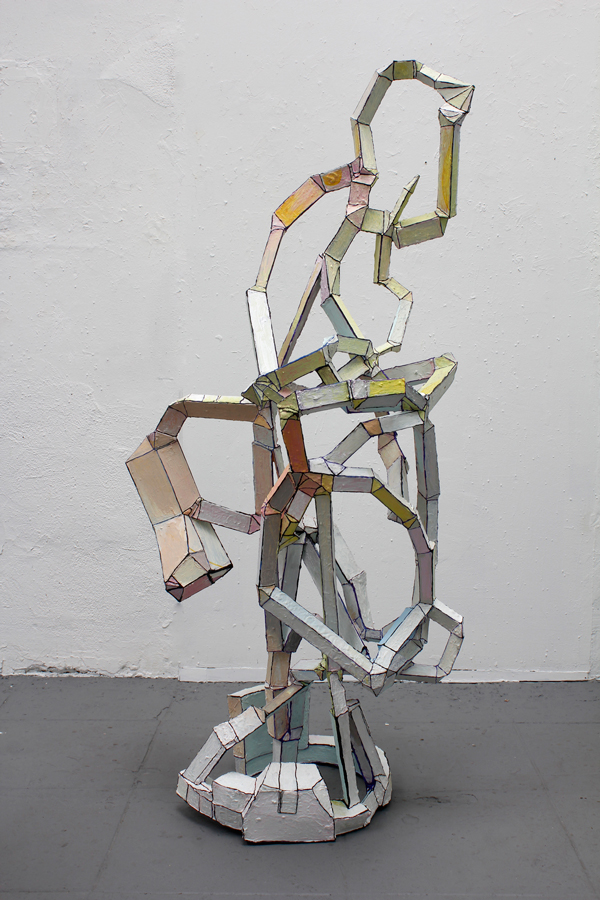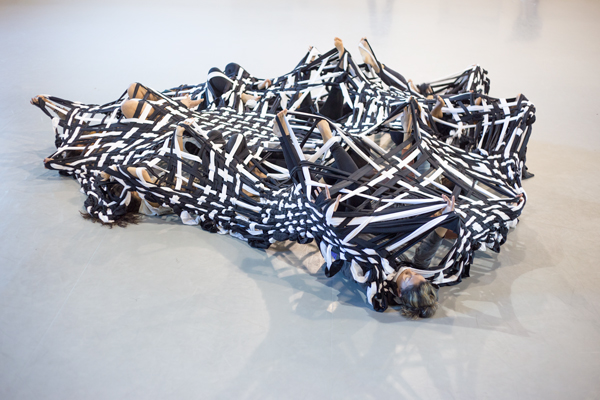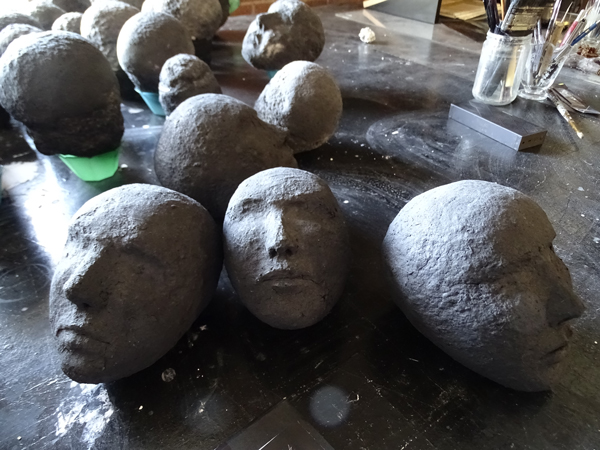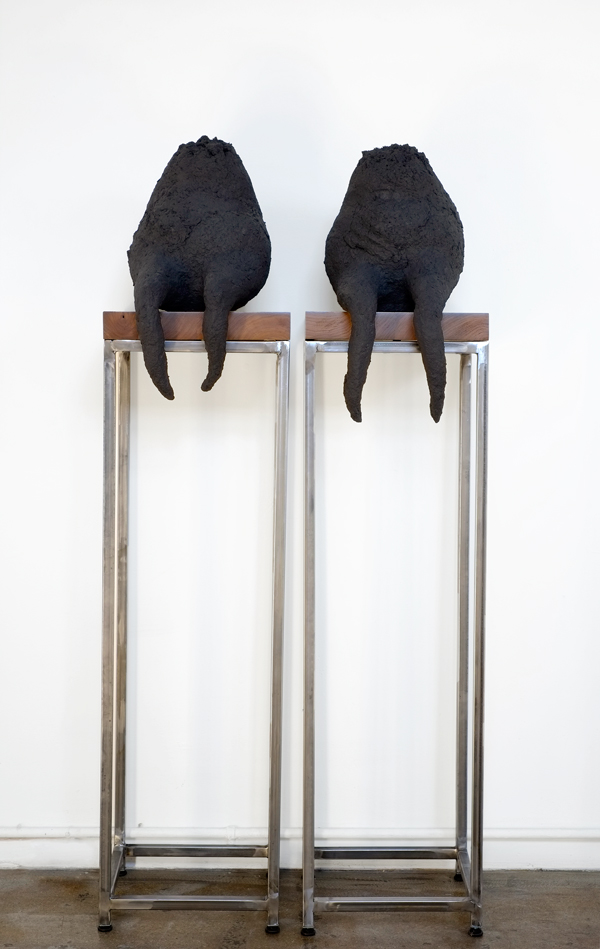As a student, seeking respite from the relatively hidebound painting department, I often retreated to the sculpture studios. There, the critical gaze of teachers seemed less intense; sculpture students did as they pleased. Around that time about a decade ago, I took Beginning Sculpture from Krysten Cunningham, who fostered critical dialogue around fundamental techniques of welding and casting. A recent visit to her Los Angeles studio, as well as that of her neighbor Maura Bendett, and the spacious loft of Camilla Taylor, revived the sense of freedom that I felt as a painter approaching sculpture.
Perhaps, then, it is no coincidence that two of these sculptors began as 2D artists. Painting and printmaking imply certain sets of media; a sculpture, however, can be nearly anything. Yet sculpture is often yoked to a limited set of usually rigid media: metal or stone, for instance; and frequently chained to a sense of machismo. Bendett, Cunningham and Taylor are forging their own paths. Each uses materials commonplace to everyday life, but not to sculpture. Their diverse oeuvres share other basic commonalities: an emphasis on the handmade; engrossments with human and animal societies. From Maura Bendett’s alien ecosystems to Krysten Cunningham’s dynamic weavings to Camilla Taylor’s somber humanoids, their individual concoctions frequently exude an almost animate presence. All three once contemplated pursuing scientific occupations. Like a researcher, each approaches her art as an open-ended investigation.

Maura Bendett’s studio, detail of work in progress, photo by Annabel Osberg.
Near an intersection flanked by a stately old manse and a liquor store on a busy stretch of West Washington Boulevard, where sidewalks meet buildings embellished with historic ornament and fresh graffiti, Bendett’s studio occupies a block interlaced with razor wire and ivy.
Bendett’s laissez-faire practice has been guided by her lifelong awe of nature. Fascinated by insects, she originally considered a career in entomology before determining that “it’s mostly about working for extermination companies.” Instead, she decided to become an artist.
As a painting student in UCLA’s MFA program, she took glassblowing and soon became enchanted, spending every spare hour forming alien-like blobs in the hot shop.
This foray affected her painting, which increasingly involved sculptural elements and shaped canvases.
Upon graduating in 1987, she found that she wanted to move beyond making art about art, and returned to her core interests, beginning with her penchant for insects: “I felt it was like looking at little dinosaurs. It was like looking at something beyond humanity—way beyond.”

Maura Bendet, detail
Over the next decade, Bendett began incorporating imagery of invertebrates, amphibians, plants and extraterrestrials into heterogeneous objects that combined painting, printmaking, drawing, sewn fabric and other media. In a breakthrough 1997 show at PØST, she exhibited patchworks of drawings interlaced by webs of fishing line. One patchwork in particular, Empire, referred to “the empire of the plant world.”
“I was never interested in humans,” she explained. Rather, she wanted to explore our relationship to other organisms and our self-appointed role as the supreme species.
“Vespid Empire,” her 2014 show at Edward Cella Art + Architecture, alluded to Modernist and Minimalist sculpture. Instead of traditional materials, her works were constructed of thickly painted illustration board joined by hot glue. They seemed to teeter with planar instability in equal reference to Futurism and rock formations.
“For me, the thing that was most interesting was how I made them,” she said. “So I decided to highlight all the edges.” Colored lines tracing every seam turn each sculpture into a drawing despite its third dimension.

Maura Bendett, Tall Sculpture, 2013, museum board, acrylic, hot glue, cement, 63 x 27 x 27″, courtesy Edward Cella Art + Architecture.
In her new work, she returns to her training as a painter, incorporating acrylic paint as a spatial element and looking to painters like Jay DeFeo for textural inspiration. Blobs of paint are only one of many materials, including glass baubles, wires and Plexiglas rods, that coalesce into her sculptural agglomerations. While determining each component’s placement, she contemplates hypothetical configurations like a painter pondering her next brushstroke.
• • •
In a West Adams studio just three doors down from Bendett, Krysten Cunningham also questions hierarchies. In contrast, her concerns center on humanity. Adorned simply with one shiny silver bangle, her sturdy hands bespoke resourcefulness as much as did her anecdotes of camping alone in the Southwestern wilderness, searching for petroglyphs on archeo-anthropological investigations. Our conversation revived memories. In critiques, she had been blunt but kind; she seemed grounded in practicality even while discussing visionary notions.
According to her, the values I observed her promote in her Beginning Sculpture class—curiosity, fellowship and independent thinking—likely germinated in her early life, especially in her upbringing on an intentional farm community in Virginia.
“Women always participated in building the houses on our farm,” she said. “It influenced me for making sculpture because all the women were making things, so I just thought naturally that I would build things.”

Krysten Cunningham, Labor and Technology (detail), 2015
As a teenager, she apprenticed with a local potter. Later, she studied anthropology at Smith College but found the environment confining, so she dropped out and traveled around the country. In Santa Fe, she studied indigenous ceramics at the Institute of American Indian Arts. Eventually, she earned a BFA from the University of New Mexico in Albuquerque in 2000 and an MFA in sculpture at UCLA in 2003.
Chris Burden, her UCLA mentor, sent her to physics research specialists for help with her sculpture involving a Foucault pendulum. This excursion led to a position in the department, where she now produces physics videos. She feels her work in the physics department complements her sculpture practice. Research on quantum encryption, for instance, informed her woven sculptures. Cunningham’s engagement with weaving encompasses its haptic, technological and societal implications. She explained, “I’m interested in technology—how we use it, how we look at it and how we might look at it differently.” In a series titled after the RGB color system, warp and weft are inspired by binary code; woven manifolds are metaphors for digital networks; and squares of interlaced fabric strips resemble pixels.
Cunningham seeks to underscore and overturn the marginalized position textiles occupy as an art form. “[Textiles] don’t share the status of sculpture,” she said. “They’re not elevated. They’re relegated to this: always malleable, always flexible, never solid.”

Krysten Cunningham, Untitled, 2015, performance at Colorado College, photo by Heather Oelklaus
In the manner of Neo-Concretists like Lygia Clark and Hélio Oiticica, Cunningham mounts interactive performances with her sculptures. She has encouraged viewers to crawl underneath her weavings and temporarily shape them while partaking in motion analogous to the kinetic efforts of the sculpture’s initial creation. Hands-on interaction affords participants a degree of agency—something she feels contemporary society fails to allow.
“Our voice, our demands, and our humanity are being eroded each year,” she elaborated. “Our civil liberties, and our ability to speak up for ourselves, and our privacy, and our space around us—more and more, we’re self-censoring. So I feel like art can potentially bring that experience back, to make us think outside of how we’re thinking.”
• • •
Camilla Taylor’s old-fashioned inclinations coexist with a contemporary outlook. She once sought to acquire furnishings produced in the decommissioned 1930s furniture factory her loft occupies but found their styles didn’t match her taste.
One of her favored mediums is cartonnage, an ancient Egyptian funerary technique. Her pointy, inchoate humanoids morphologically resemble Bendett’s spindled forms. In contrast to Bendett’s reaching “way beyond,” Taylor seeks to excavate humanity’s innards.
Taylor’s early career path parallels that of Bendett. She wanted to be an entomologist. While attending high school in Provo, Utah, she interned with scientists researching wasps. However, on a 1998 bus trip to LACMA, she was so impressed by Michael C. McMillen’s installation The Garage (1981) that she changed her plans. She had always enjoyed dabbling in art; but, never having been exposed to much contemporary work, she had never before realized its conceptual potential.
She earned her BFA in printmaking from the University of Utah, Salt Lake City in 2006. She lost access to the school’s printing presses after graduating, so she began sculpting small figures from clay and fabric. At CSULB, where she earned her MFA in 2011, she fabricated stuffed chimera from cloth prints.

Inside Camilla Taylor’s studio, detail of work in progress that will include 108 cartonnage heads, photo by Annabel Osberg.
“I loved the way they had three-dimensional and two-dimensional aspects at the same time, that weirdness of existing in the same space,” she reflected. Though her work has evolved, she continues to strive for that effect. In “Waiting Shadows,” her 2015 exhibition at Bermudez Projects, black sculptures contrasted with white walls to appear flat from afar, like ink drawings. Textural details like strings, stitches and viscid cartonnage slowly emerged as one approached.
“The way someone reacts to a three-dimensional object, to me, becomes so much more personal,” she said. “I’ve never felt protective of a painting. But I feel protective of objects—or more empathy towards objects—because they exist in the space with me.”
Empathy is essential, for she wants her figures to “feel like they’re familiar, like they’re from a subconscious space in the brain.” She acknowledges the influence of Louise Bourgeois, Kiki Smith and Magdalena Abakanowicz, but asserts that her work is neither as confessional nor specifically personal.
Taylor shares with Cunningham a preoccupation with counterposing hardness and softness, and a flair for exaggeration of scale. In Patience (2015), a metal chain suspends a pitchy figure whose grotesquely elongated arms dangle like limp spaghetti, ending in pewter hands on the floor.

Camilla Taylor, It Wasn’t Until Then, 2014, cartonnage, walnut, welded steel, 52 x 13 12” (individually), photo by Mike Reynolds.
Lately, she is experimenting with nonobjectivity. A new series called “The Past” is made from failed drawings cut up and stratified like old tomes or fish scales.
A concurrent work in progress will feature 108 tarry heads. “Initially they’ll look like just a pile of coal, but then you start to see that each individual face is different and each one is a different size,” she described.
With their indistinct features, fractionalization, and spindly charred limbs, Taylor’s figurative sculptures are redolent of mummies.
“I like thinking about Pompeii,” she said. “Looking at those figures, there’s something universal and undeniable that feels so immediate and intimate. Even though their culture is completely foreign to us, the experience of those figures—we understand them immediately—is so timeless that it becomes this universal language.” She seeks to imbue her sculptures with evocativeness that feels singular yet transcends time and place, like Easter Island moai, the Venus of Willendorf, or Giacometti’s elongated bronzes.
Like those of Bendett and Cunningham, Taylor’s distorted forms challenge conventions while investigating existential questions. Given their intriguing viewpoints and idiosyncratic methodologies, it is little wonder that the three artists unite in their interest in natural science.
Each in different ways, Bendett, Cunningham and Taylor are sculpting alternate empires out of touchstones mined from personal experiences and realms of the past. Cutting free from binding restraints of tradition, each in her unique way has navigated a journey to a fresh vision of “sculpture.”


















0 Comments